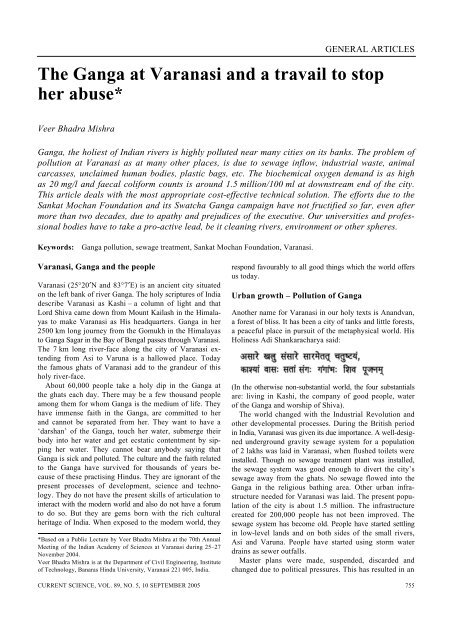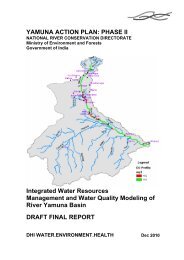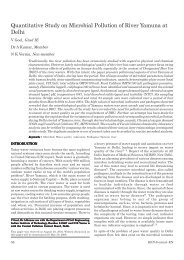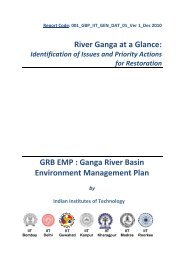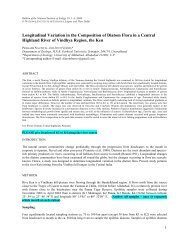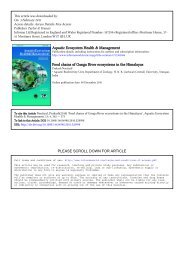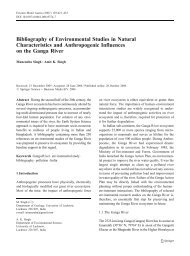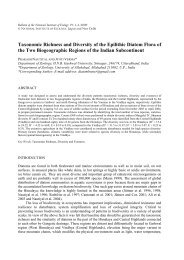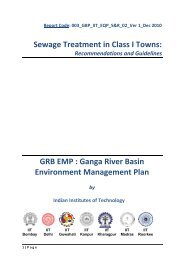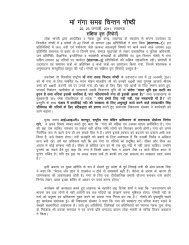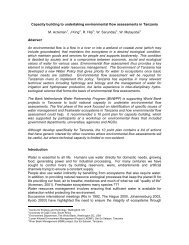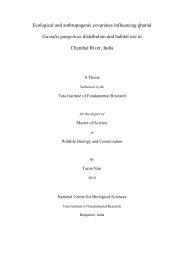The Ganga at Varanasi and a travail to stop her abuse - GANGAPEDIA
The Ganga at Varanasi and a travail to stop her abuse - GANGAPEDIA
The Ganga at Varanasi and a travail to stop her abuse - GANGAPEDIA
Create successful ePaper yourself
Turn your PDF publications into a flip-book with our unique Google optimized e-Paper software.
GENERAL ARTICLES<br />
<strong>The</strong> <strong>Ganga</strong> <strong>at</strong> <strong>Varanasi</strong> <strong>and</strong> a <strong>travail</strong> <strong>to</strong> s<strong>to</strong>p<br />
<strong>her</strong> <strong>abuse</strong>*<br />
Veer Bhadra Mishra<br />
<strong>Ganga</strong>, the holiest of Indian rivers is highly polluted near many cities on its banks. <strong>The</strong> problem of<br />
pollution <strong>at</strong> <strong>Varanasi</strong> as <strong>at</strong> many ot<strong>her</strong> places, is due <strong>to</strong> sewage inflow, industrial waste, animal<br />
carcasses, unclaimed human bodies, plastic bags, etc. <strong>The</strong> biochemical oxygen dem<strong>and</strong> is as high<br />
as 20 mg/l <strong>and</strong> faecal coliform counts is around 1.5 million/100 ml <strong>at</strong> downstream end of the city.<br />
This article deals with the most appropri<strong>at</strong>e cost-effective technical solution. <strong>The</strong> efforts due <strong>to</strong> the<br />
Sank<strong>at</strong> Mochan Found<strong>at</strong>ion <strong>and</strong> its Sw<strong>at</strong>cha <strong>Ganga</strong> campaign have not fructified so far, even after<br />
more than two decades, due <strong>to</strong> ap<strong>at</strong>hy <strong>and</strong> prejudices of the executive. Our universities <strong>and</strong> professional<br />
bodies have <strong>to</strong> take a pro-active lead, be it cleaning rivers, environment or ot<strong>her</strong> sp<strong>her</strong>es.<br />
Keywords: <strong>Ganga</strong> pollution, sewage tre<strong>at</strong>ment, Sank<strong>at</strong> Mochan Found<strong>at</strong>ion, <strong>Varanasi</strong>.<br />
<strong>Varanasi</strong>, <strong>Ganga</strong> <strong>and</strong> the people<br />
<strong>Varanasi</strong> (25°20′N <strong>and</strong> 83°7′E) is an ancient city situ<strong>at</strong>ed<br />
on the left bank of river <strong>Ganga</strong>. <strong>The</strong> holy scriptures of India<br />
describe <strong>Varanasi</strong> as Kashi – a column of light <strong>and</strong> th<strong>at</strong><br />
Lord Shiva came down from Mount Kailash in the Himalayas<br />
<strong>to</strong> make <strong>Varanasi</strong> as His headquarters. <strong>Ganga</strong> in <strong>her</strong><br />
2500 km long journey from the Gomukh in the Himalayas<br />
<strong>to</strong> <strong>Ganga</strong> Sagar in the Bay of Bengal passes through <strong>Varanasi</strong>.<br />
<strong>The</strong> 7 km long river-face along the city of <strong>Varanasi</strong> extending<br />
from Asi <strong>to</strong> Varuna is a hallowed place. Today<br />
the famous gh<strong>at</strong>s of <strong>Varanasi</strong> add <strong>to</strong> the gr<strong>and</strong>eur of this<br />
holy river-face.<br />
About 60,000 people take a holy dip in the <strong>Ganga</strong> <strong>at</strong><br />
the gh<strong>at</strong>s each day. <strong>The</strong>re may be a few thous<strong>and</strong> people<br />
among them for whom <strong>Ganga</strong> is the medium of life. <strong>The</strong>y<br />
have immense faith in the <strong>Ganga</strong>, are committed <strong>to</strong> <strong>her</strong><br />
<strong>and</strong> cannot be separ<strong>at</strong>ed from <strong>her</strong>. <strong>The</strong>y want <strong>to</strong> have a<br />
‘darshan’ of the <strong>Ganga</strong>, <strong>to</strong>uch <strong>her</strong> w<strong>at</strong>er, submerge their<br />
body in<strong>to</strong> <strong>her</strong> w<strong>at</strong>er <strong>and</strong> get ecst<strong>at</strong>ic contentment by sipping<br />
<strong>her</strong> w<strong>at</strong>er. <strong>The</strong>y cannot bear anybody saying th<strong>at</strong><br />
<strong>Ganga</strong> is sick <strong>and</strong> polluted. <strong>The</strong> culture <strong>and</strong> the faith rel<strong>at</strong>ed<br />
<strong>to</strong> the <strong>Ganga</strong> have survived for thous<strong>and</strong>s of years because<br />
of these practising Hindus. <strong>The</strong>y are ignorant of the<br />
present processes of development, science <strong>and</strong> technology.<br />
<strong>The</strong>y do not have the present skills of articul<strong>at</strong>ion <strong>to</strong><br />
interact with the modern world <strong>and</strong> also do not have a forum<br />
<strong>to</strong> do so. But they are gems born with the rich cultural<br />
<strong>her</strong>itage of India. When exposed <strong>to</strong> the modern world, they<br />
*Based on a Public Lecture by Veer Bhadra Mishra <strong>at</strong> the 70th Annual<br />
Meeting of the Indian Academy of Sciences <strong>at</strong> <strong>Varanasi</strong> during 25–27<br />
November 2004.<br />
Veer Bhadra Mishra is <strong>at</strong> the Department of Civil Engineering, Institute<br />
of Technology, Banaras Hindu University, <strong>Varanasi</strong> 221 005, India.<br />
respond favourably <strong>to</strong> all good things which the world offers<br />
us <strong>to</strong>day.<br />
Urban growth – Pollution of <strong>Ganga</strong><br />
Anot<strong>her</strong> name for <strong>Varanasi</strong> in our holy texts is An<strong>and</strong>van,<br />
a forest of bliss. It has been a city of tanks <strong>and</strong> little forests,<br />
a peaceful place in pursuit of the metaphysical world. His<br />
Holiness Adi Shankaracharya said:<br />
(In the ot<strong>her</strong>wise non-substantial world, the four substantials<br />
are: living in Kashi, the company of good people, w<strong>at</strong>er<br />
of the <strong>Ganga</strong> <strong>and</strong> worship of Shiva).<br />
<strong>The</strong> world changed with the Industrial Revolution <strong>and</strong><br />
ot<strong>her</strong> developmental processes. During the British period<br />
in India, <strong>Varanasi</strong> was given its due importance. A well-designed<br />
underground gravity sewage system for a popul<strong>at</strong>ion<br />
of 2 lakhs was laid in <strong>Varanasi</strong>, when flushed <strong>to</strong>ilets were<br />
installed. Though no sewage tre<strong>at</strong>ment plant was installed,<br />
the sewage system was good enough <strong>to</strong> divert the city’s<br />
sewage away from the gh<strong>at</strong>s. No sewage flowed in<strong>to</strong> the<br />
<strong>Ganga</strong> in the religious b<strong>at</strong>hing area. Ot<strong>her</strong> urban infrastructure<br />
needed for <strong>Varanasi</strong> was laid. <strong>The</strong> present popul<strong>at</strong>ion<br />
of the city is about 1.5 million. <strong>The</strong> infrastructure<br />
cre<strong>at</strong>ed for 200,000 people has not been improved. <strong>The</strong><br />
sewage system has become old. People have started settling<br />
in low-level l<strong>and</strong>s <strong>and</strong> on both sides of the small rivers,<br />
Asi <strong>and</strong> Varuna. People have started using s<strong>to</strong>rm w<strong>at</strong>er<br />
drains as sewer outfalls.<br />
Master plans were made, suspended, discarded <strong>and</strong><br />
changed due <strong>to</strong> political pressures. This has resulted in an<br />
CURRENT SCIENCE, VOL. 89, NO. 5, 10 SEPTEMBER 2005 755
GENERAL ARTICLES<br />
unplanned development of <strong>Varanasi</strong> in the last 50 years.<br />
<strong>The</strong> capacity of the old sewers has been exceeded <strong>and</strong> the<br />
city’s sewage <strong>and</strong> industrial waste flow in<strong>to</strong> the river in<br />
the religious b<strong>at</strong>hing area also, through 30 point sources,<br />
i.e. sewer outfalls, open drains <strong>and</strong> ot<strong>her</strong> outlets. <strong>The</strong> maximum<br />
popul<strong>at</strong>ion density of the city near Shri Vishwan<strong>at</strong>h<br />
Temple is 100,000 per km 2 . People have pet animals in<br />
their houses. No arrangement exists for solid waste disposal,<br />
including disposal of the animal carcasses. Firewood is<br />
becoming costlier everyday. It is difficult for the ‘Shmashan<br />
Gh<strong>at</strong>’ (crem<strong>at</strong>ion ground) <strong>to</strong> cope with the pressure of increasing<br />
number of crem<strong>at</strong>ions done on the river bank.<br />
<strong>The</strong> result has been <strong>abuse</strong> of mot<strong>her</strong> <strong>Ganga</strong>. <strong>The</strong> <strong>to</strong>tal sewage<br />
<strong>and</strong> industrial effluent of <strong>Varanasi</strong> is flowing in<strong>to</strong> the<br />
river along the gh<strong>at</strong>s of <strong>Varanasi</strong>. Garbage, dead bodies<br />
of animals <strong>and</strong> unclaimed human bodies, plastic bags, etc.<br />
are also thrown in<strong>to</strong> the river w<strong>her</strong>e people take a holy<br />
dip. In 1986, according <strong>to</strong> Government’s estim<strong>at</strong>es, about<br />
147 million litres per day (MLD) of sewage <strong>and</strong> industrial<br />
waste gener<strong>at</strong>ed in <strong>Varanasi</strong> flowed in<strong>to</strong> the <strong>Ganga</strong>. Now,<br />
over 200 MLD of wastew<strong>at</strong>er is flowing in<strong>to</strong> the river.<br />
<strong>Ganga</strong>’s capacity <strong>to</strong> bear the aforesaid <strong>abuse</strong> is exhausted.<br />
She is sick in <strong>Varanasi</strong>. Along the gh<strong>at</strong>s of <strong>Varanasi</strong>,<br />
<strong>Ganga</strong> w<strong>at</strong>er is polluted. About 95% of this pollution is<br />
caused by sewage flowing in<strong>to</strong> the river from the point<br />
sources of pollution described above. <strong>The</strong> level of this<br />
pollution can be quantified by biochemical oxygen dem<strong>and</strong><br />
(BOD) in mg/l of the river w<strong>at</strong>er, which is a measure of<br />
organic m<strong>at</strong>ter present in w<strong>at</strong>er, <strong>and</strong> the number of faecal<br />
coliform counts (FCC)/100 ml of w<strong>at</strong>er sample, indic<strong>at</strong>ing<br />
the presence of faecal coliform bacteria in w<strong>at</strong>er, the root<br />
cause of practically all w<strong>at</strong>er-borne diseases. <strong>The</strong> BOD of<br />
<strong>Ganga</strong> w<strong>at</strong>er in Asi, <strong>at</strong> the beginning of the city is around<br />
4 mg/l <strong>and</strong> FCC/100 ml is around 60,000. <strong>The</strong> river flows<br />
downstream from this point <strong>and</strong> the quality of <strong>Ganga</strong> w<strong>at</strong>er <strong>at</strong><br />
the end of the <strong>to</strong>wn <strong>at</strong> the Varuna confluence is poor,<br />
with BOD equal <strong>to</strong> 20 mg/l or more <strong>and</strong> FCC around 1.5<br />
million/100 ml. <strong>The</strong> river w<strong>at</strong>er <strong>at</strong> the end of the <strong>to</strong>wn is<br />
grey <strong>and</strong> stinks, with methane bubbles coming <strong>to</strong> the surface.<br />
This is a serious m<strong>at</strong>ter. <strong>The</strong> river along the gh<strong>at</strong>s of <strong>Varanasi</strong><br />
is used culturally, <strong>and</strong> is used for sipping, drinking <strong>and</strong><br />
worship in the temples. <strong>Ganga</strong>’s design<strong>at</strong>ed use in holy<br />
cities like <strong>Varanasi</strong> cannot be defined by class A, class B<br />
or class C rivers. <strong>The</strong> media <strong>and</strong> planners these days classify<br />
<strong>Ganga</strong> as class B river for which BOD < 3 mg/l <strong>and</strong> FCC<br />
< 500/100 ml. Without accepting it, even if this criterion<br />
for the <strong>Ganga</strong> is quoted for discussion, the river is heavily<br />
polluted along the gh<strong>at</strong>s of <strong>Varanasi</strong>. <strong>The</strong> condition of the<br />
river w<strong>at</strong>er in all the big cities (more than five in number)<br />
situ<strong>at</strong>ed along the <strong>Ganga</strong> is more or less like th<strong>at</strong> of the<br />
<strong>Ganga</strong> in <strong>Varanasi</strong>. In smaller cities (about 100 in number)<br />
the river is polluted, but pollution level is lower than th<strong>at</strong><br />
<strong>at</strong> <strong>Varanasi</strong>.<br />
<strong>The</strong> encouraging or brighter part of this disgusting situ<strong>at</strong>ion<br />
is th<strong>at</strong> the entire 2500 km length of the <strong>Ganga</strong> is not polluted.<br />
Dissolved oxygen level in <strong>Ganga</strong> w<strong>at</strong>er is good <strong>and</strong><br />
756<br />
fish can be found in most parts of the river. River w<strong>at</strong>er<br />
even <strong>at</strong> the worst polluted places is better in the midstream<br />
<strong>and</strong> also <strong>at</strong> a distance of several kilometres from the city<br />
on its upstream <strong>and</strong> downstream sides. Thus the whole<br />
river is not polluted.<br />
Technically speaking, if point sources discharging pollutants<br />
in the river are firmly s<strong>to</strong>pped, 95% of the river pollution<br />
will be elimin<strong>at</strong>ed. <strong>The</strong> city’s wastew<strong>at</strong>er must be<br />
tre<strong>at</strong>ed appropri<strong>at</strong>ely <strong>to</strong> make it innocuous for reuse in<br />
fields <strong>and</strong> ot<strong>her</strong> such places. In <strong>to</strong>day’s world <strong>and</strong> for a<br />
river like <strong>Ganga</strong> in <strong>Varanasi</strong> this can definitely be done.<br />
It is the responsibility of all of us <strong>to</strong> do this.<br />
<strong>The</strong> remaining 5% of the river pollution is caused by<br />
non-point sources. <strong>The</strong> society has <strong>to</strong> be educ<strong>at</strong>ed <strong>and</strong><br />
made environmentally conscious <strong>to</strong> deal with this 5%<br />
pollution.<br />
<strong>The</strong> Sank<strong>at</strong> Mochan Found<strong>at</strong>ion <strong>and</strong> its ‘Sw<strong>at</strong>cha<br />
<strong>Ganga</strong>’ campaign<br />
<strong>The</strong> aforesaid problem of pollution of <strong>Ganga</strong> <strong>at</strong> <strong>Varanasi</strong><br />
<strong>and</strong> its solution were carefully examined by a set of teac<strong>her</strong>s<br />
from Banaras Hindu University (BHU), <strong>Varanasi</strong> <strong>and</strong> citizens<br />
of <strong>Varanasi</strong> committed <strong>to</strong> the <strong>Ganga</strong> <strong>and</strong> the Indian tradition,<br />
<strong>and</strong> who have the necessary technical <strong>and</strong><br />
scientific knowledge. Initial m<strong>at</strong>erial support came from<br />
the Sank<strong>at</strong> Mochan Temple established by Goswami Tulsidas,<br />
the celebr<strong>at</strong>ed saint poet who wrote Ramacharit Manas.<br />
Legal formalities <strong>to</strong> cre<strong>at</strong>e a secular found<strong>at</strong>ion<br />
named as Sank<strong>at</strong> Mochan Found<strong>at</strong>ion (SMF) were completed<br />
in 1982, when SMF came in<strong>to</strong> existence. All the aforesaid<br />
committed persons became members of SMF. A ‘Sw<strong>at</strong>cha<br />
<strong>Ganga</strong>’ campaign was launched in the same year. Enthusiasm<br />
<strong>and</strong> optimism were seen in every step of the Found<strong>at</strong>ion.<br />
SMF was a tiny organiz<strong>at</strong>ion <strong>and</strong> it is tiny even<br />
<strong>to</strong>day, but the work needed <strong>to</strong> clean the <strong>Ganga</strong> was very<br />
big – much bigger than the capacity of SMF. <strong>The</strong> found<strong>at</strong>ion<br />
wisely decided <strong>to</strong> act as a c<strong>at</strong>alytic agent, work with the<br />
people <strong>and</strong> spread the message of ‘clean <strong>Ganga</strong>’ <strong>and</strong> the<br />
need for everybody’s particip<strong>at</strong>ion <strong>and</strong> assistance <strong>to</strong> accomplish<br />
the objective of a clean <strong>Ganga</strong>. <strong>Varanasi</strong> was chosen<br />
as the place <strong>to</strong> start work.<br />
SMF’s work as a c<strong>at</strong>alytic agent <strong>to</strong> clean the <strong>Ganga</strong><br />
comprised of talks <strong>at</strong> street corner meetings, organizing<br />
conferences for women, bo<strong>at</strong>men, P<strong>and</strong>as (priests sitting<br />
on the gh<strong>at</strong>s), dance dramas <strong>and</strong> painting competitions by<br />
school children, poets’ conferences, etc. All these activities<br />
designed <strong>to</strong> reach out <strong>to</strong> the society proved effective.<br />
Rajiv G<strong>and</strong>hi as Prime Minister of India, in his first address<br />
<strong>to</strong> the n<strong>at</strong>ion, urged people <strong>to</strong> come forward <strong>to</strong> save<br />
<strong>Ganga</strong> <strong>and</strong> his government decided <strong>to</strong> launch <strong>Ganga</strong> Action<br />
Plan (GAP) <strong>to</strong> clean the river in <strong>Varanasi</strong> <strong>and</strong> some ot<strong>her</strong><br />
cities. <strong>The</strong> Indian bureaucracy monopolized the GAP <strong>to</strong><br />
have control over the abundant funds made available for<br />
it. <strong>The</strong> twin objectives of GAP were <strong>to</strong> intercept <strong>and</strong> di-<br />
CURRENT SCIENCE, VOL. 89, NO. 5, 10 SEPTEMBER 2005
vert the sewage so th<strong>at</strong> it reaches the sewage tre<strong>at</strong>ment<br />
plant (STP), <strong>and</strong> make the effluent of the STP innocuous<br />
for use in agriculture <strong>and</strong> such ot<strong>her</strong> activities. <strong>The</strong> government<br />
with its nodal agency implemented GAP in <strong>Varanasi</strong><br />
between 1986 <strong>and</strong> 1993. Five sewage pumps were installed<br />
<strong>to</strong> intercept sewage flowing in<strong>to</strong> the river from 30<br />
point sources. Out of the 147 MLD sewage gener<strong>at</strong>ed in<br />
<strong>Varanasi</strong> only 122 MLD was s<strong>to</strong>pped from flowing in<strong>to</strong><br />
the <strong>Ganga</strong> <strong>and</strong> 102.9 MLD was tre<strong>at</strong>ed in the STPs. However,<br />
the STP did not control faecal coliform bacteria. But the<br />
government argued with SMF th<strong>at</strong> its GAP was successful.<br />
SMF was disappointed, helpless <strong>and</strong> challenged by<br />
such an outrageous st<strong>at</strong>ement.<br />
SMF <strong>to</strong>ok the challenge. It g<strong>at</strong><strong>her</strong>ed funds <strong>to</strong> cre<strong>at</strong>e the<br />
Sw<strong>at</strong>cha <strong>Ganga</strong> Research Labor<strong>at</strong>ory (SGRL) situ<strong>at</strong>ed <strong>at</strong><br />
Tulsi Gh<strong>at</strong>, which moni<strong>to</strong>red the river w<strong>at</strong>er quality every<br />
day. <strong>The</strong> published d<strong>at</strong>a of SGRL’s moni<strong>to</strong>ring exercise<br />
exposed <strong>and</strong> embarrassed the government. SMF proved<br />
th<strong>at</strong> during electrical power failure (which happens every<br />
day) <strong>and</strong> during the five months of the flood season, the<br />
sewage pumps did not work <strong>and</strong> <strong>to</strong>tal sewage of the city<br />
passed in<strong>to</strong> the river every day. <strong>The</strong> tre<strong>at</strong>ed effluent of the<br />
Figure 1. SMF–VNN proposed PFR for GAP phase II <strong>at</strong> <strong>Varanasi</strong>.<br />
GENERAL ARTICLES<br />
STPs was ruining the health of the villagers, their crops<br />
<strong>and</strong> the groundw<strong>at</strong>er. This str<strong>at</strong>egy of SMF in exposing<br />
the faults of GAP made the government defensive. <strong>The</strong><br />
government made proposals <strong>to</strong> implement GAP Phase II<br />
in 1994 <strong>and</strong> got money sanctioned for its implement<strong>at</strong>ion.<br />
But in the new plans, the faults of the earlier GAP were<br />
not corrected.<br />
<strong>Varanasi</strong> Nagar Nigam <strong>and</strong> Sank<strong>at</strong> Mochan<br />
Found<strong>at</strong>ion as public–priv<strong>at</strong>e partners <strong>to</strong> clean<br />
<strong>Ganga</strong><br />
<strong>Varanasi</strong> Nagar Nigam (VNN), after receiving the powers<br />
given <strong>to</strong> it by the 74th Amendment of the Indian Constitution,<br />
decided <strong>to</strong> prepare its own proposal for GAP Phase<br />
II. VNN requested SMF <strong>to</strong> make this altern<strong>at</strong>ive proposal.<br />
SMF’s team of experts from India <strong>and</strong> USA made this altern<strong>at</strong>ive<br />
proposal for GAP Phase II. Details are given<br />
l<strong>at</strong>er in this article. VNN unanimously accepted this altern<strong>at</strong>ive<br />
proposal in the form of a project feasibility report<br />
(PFR) known as VNN–SMF PFR for GAP Phase II <strong>and</strong><br />
CURRENT SCIENCE, VOL. 89, NO. 5, 10 SEPTEMBER 2005 757
GENERAL ARTICLES<br />
requested the government <strong>to</strong> release funds for its implement<strong>at</strong>ion.<br />
<strong>The</strong> schem<strong>at</strong>ic loc<strong>at</strong>ion of the sewerage system<br />
<strong>and</strong> tre<strong>at</strong>ment plant suggested in the proposed PFR is<br />
shown in Figure 1 (refs 6, 7).<br />
<strong>The</strong> VNN–SMF PFR has been appraised by government’s<br />
experts. Good suggestions coming out of this appraisal<br />
exercise were incorpor<strong>at</strong>ed in the VNN–SMF PFR<br />
for GAP Phase II in 1998. But the Government rejected<br />
the VNN–SMF PFR <strong>and</strong> insulted the VNN. About 56 corpor<strong>at</strong>ors<br />
of VNN filed a PIL against this action of the government.<br />
Since 1998, the m<strong>at</strong>ter is pending in the court of law.<br />
In the meantime, the government insisted th<strong>at</strong> its PFR<br />
for GAP Phase II be considered by VNN. However, VNN<br />
did not find it suitable for <strong>Varanasi</strong>. <strong>The</strong> government’s PFR<br />
for GAP Phase II has been returned with five objections<br />
raised by the VNN.<br />
<strong>The</strong> government appointed technical committees <strong>to</strong> examine<br />
both the PFRs. <strong>The</strong>se technical committees have<br />
given their recommend<strong>at</strong>ions in favour of the VNN–SMF<br />
PFR. This PFR is less expensive in all respects than the<br />
government PFR. <strong>The</strong> government is not acting on the reports<br />
of the committees th<strong>at</strong> have recommended VNN–<br />
SMF PFR.<br />
<strong>The</strong> VNN–SMF PFR has been unanimously accepted<br />
by the General Body of the VNN. It meets all the local<br />
needs. <strong>The</strong> work of SMF with VNN is exemplary. A real<br />
public–priv<strong>at</strong>e partnership has done the capacity building<br />
of VNN <strong>and</strong> has s<strong>to</strong>pped the wrong-doings of people in<br />
power in m<strong>at</strong>ters of GAP Phase II. Ot<strong>her</strong> municipal corpor<strong>at</strong>ions<br />
<strong>and</strong> Nagar Nigams have succumbed <strong>to</strong> the pressure<br />
of the government. <strong>The</strong>y have allowed the government <strong>to</strong><br />
plan GAP phase II in their cities <strong>and</strong> implement them.<br />
Hundreds of crores of rupees were spent once again in<br />
these cities, but the <strong>Ganga</strong> could not be cleaned. <strong>Varanasi</strong><br />
is the only city w<strong>her</strong>e the Nagar Nigam is struggling for<br />
its rights <strong>to</strong> set up an appropri<strong>at</strong>e system <strong>to</strong> clean the river<br />
<strong>and</strong> its environment. SMF is drawing every ounce of its<br />
energy <strong>to</strong> support VNN. <strong>The</strong> struggle continues <strong>and</strong> <strong>Ganga</strong><br />
continues <strong>to</strong> be polluted.<br />
It is hard <strong>to</strong> believe th<strong>at</strong> prejudices <strong>and</strong> mindset of the<br />
people in power can go <strong>to</strong> this extent <strong>to</strong> s<strong>to</strong>p implement<strong>at</strong>ion<br />
of a proposal, which is technically most appropri<strong>at</strong>e<br />
for <strong>Varanasi</strong> <strong>and</strong> is most economical <strong>and</strong> has the support<br />
of the people. Constitutional rights of the III Tier of the<br />
government (which VNN is <strong>to</strong>day) <strong>to</strong> decide its plan <strong>to</strong><br />
clean the <strong>Ganga</strong> <strong>and</strong> implement it, have been denied by<br />
the government. Supporters of VNN are called ‘hounds’<br />
<strong>and</strong> the government’s important functionaries have said<br />
openly th<strong>at</strong> such NGOs should be driven out of the <strong>to</strong>wn.<br />
It is a painful experience <strong>and</strong> the pain becomes acute<br />
when we realize th<strong>at</strong> for the same work, SMF received<br />
Global 500 Roll of Honour in 1992 <strong>at</strong> Rio on the occasion<br />
of UN’s celebr<strong>at</strong>ed conference UNCED <strong>and</strong> the Earth Summit.<br />
Time magazine during the millennium year nomin<strong>at</strong>ed<br />
SMF’s President as one of ‘seven <strong>her</strong>oes of the<br />
planet’. In the year 2000 President Clin<strong>to</strong>n invited SMF’s<br />
758<br />
President <strong>to</strong> share the podium with him <strong>at</strong> Agra, when he<br />
(Clin<strong>to</strong>n) gave a public lecture on the environment. He<br />
openly praised SMF’s work as a unique example of faith<br />
<strong>and</strong> science.<br />
<strong>The</strong> New Yorker magazine has covered our work in right<br />
perspective in a ten-page article in 1998, but the media in<br />
India has never gone in<strong>to</strong> the details of the work th<strong>at</strong>.<br />
SMF is doing for cleaning the <strong>Ganga</strong> by combining faith <strong>and</strong><br />
science. An Indian magazine sees this combin<strong>at</strong>ion of science<br />
<strong>and</strong> faith as weakness of the ‘Sw<strong>at</strong>cha <strong>Ganga</strong>’ campaign.<br />
It finds religious rites of Hindus in <strong>Varanasi</strong> <strong>and</strong> a combin<strong>at</strong>ion<br />
of science <strong>and</strong> faith as reasons for increasing pollution<br />
of <strong>Ganga</strong> in <strong>Varanasi</strong>. <strong>The</strong> World Bank thinks th<strong>at</strong><br />
development <strong>and</strong> environmental protection cannot be<br />
done without combining faith, spiritual approach <strong>and</strong> science.<br />
Ted Turner’s UN Found<strong>at</strong>ion found the solution given by<br />
SMF for GAP Phase II <strong>at</strong> <strong>Varanasi</strong> <strong>to</strong> be excellent <strong>and</strong> offered<br />
<strong>to</strong> give full assistance <strong>to</strong> this project. But the Government<br />
of India <strong>to</strong>ld UNDP th<strong>at</strong> NGOs could not be encouraged<br />
in infrastructure building. <strong>The</strong> government invites Japan<br />
Intern<strong>at</strong>ional Cooper<strong>at</strong>ion Agency (JICA), Government of<br />
Japan <strong>to</strong> do the job of cleaning the <strong>Ganga</strong>. JICA finds the<br />
work bankable <strong>and</strong> submits its proposal for giving Japan<br />
Bank for Intern<strong>at</strong>ional Cooper<strong>at</strong>ion’s (JBIC’s) loan <strong>to</strong><br />
VNN for implementing the Uttar Pradesh Jal Nigam<br />
(UPJN) PFR for GAP Phase II (Figures 2 <strong>and</strong> 3) (refs 8,<br />
9). JICA has submitted a plan for enhanced tax<strong>at</strong>ion on<br />
the people of <strong>Varanasi</strong> <strong>to</strong> recover its loan. VNN does not<br />
accept this. <strong>The</strong> government dissuades the UNDP <strong>to</strong> give<br />
grant-in-aid for <strong>Ganga</strong> in <strong>Varanasi</strong>, but encourages JICA<br />
<strong>to</strong> work on this project <strong>to</strong> earn profit <strong>and</strong> tax the people.<br />
VNN’s chief executive working under the Government of<br />
Uttar Pradesh agrees with JICA <strong>and</strong> does not find himself<br />
oblig<strong>at</strong>ed <strong>to</strong> carry out VNN’s resolution in respect of<br />
GAP Phase II. Small financial assistance given by Intern<strong>at</strong>ional<br />
Development Agencies of governments like<br />
Sweden <strong>and</strong> USA directly <strong>to</strong> NGOs may also s<strong>to</strong>p, because<br />
the Government of India has taken a policy decision<br />
th<strong>at</strong> foreign assistance <strong>to</strong> NGOs may not be given directly.<br />
NRIs living outside India want <strong>to</strong> support gurus, temples<br />
<strong>and</strong> Hindu organiz<strong>at</strong>ions <strong>and</strong> they are not so interested in<br />
NGO activities going on in India for development <strong>and</strong> appropri<strong>at</strong>e<br />
use of technologies. Big intern<strong>at</strong>ional found<strong>at</strong>ions<br />
want NGOs <strong>to</strong> work in areas, which are favoured by<br />
these found<strong>at</strong>ions. Hence SMF is not able <strong>to</strong> get funds<br />
from them also. SMF does not have staff <strong>and</strong> energy <strong>to</strong><br />
simultaneously work <strong>to</strong> gener<strong>at</strong>e resources <strong>and</strong> continue<br />
with the pressure struggle.<br />
Wh<strong>at</strong> should we do? W<strong>her</strong>e shall we go? We know th<strong>at</strong><br />
we are doing right things <strong>and</strong> working with commitment<br />
<strong>to</strong> clean the <strong>Ganga</strong> <strong>and</strong> using all our technical skills <strong>and</strong> energy<br />
<strong>to</strong> achieve the goal of a clean <strong>Ganga</strong>. This s<strong>to</strong>ry<br />
needs exposure <strong>at</strong> the widest level. We started working<br />
when our hair was black <strong>and</strong> we are still working for a<br />
clean <strong>Ganga</strong> <strong>at</strong> <strong>Varanasi</strong> when our hair has greyed. No<br />
tangible results so far. We are not going <strong>to</strong> be deterred<br />
CURRENT SCIENCE, VOL. 89, NO. 5, 10 SEPTEMBER 2005
from the p<strong>at</strong>h we have chosen <strong>to</strong> clean the <strong>Ganga</strong> <strong>at</strong> <strong>Varanasi</strong>.<br />
We have the same enthusiasm, which we had in 1982.<br />
Hope this <strong>travail</strong> will come <strong>to</strong> a happy end when appropri<strong>at</strong>e<br />
infrastructure <strong>to</strong> clean the river is put in place <strong>and</strong><br />
the river gets cleaned. <strong>The</strong> example thus set in <strong>Varanasi</strong> will<br />
inspire ot<strong>her</strong> river cities <strong>to</strong> take care of the river in their<br />
own terri<strong>to</strong>ry.<br />
<strong>The</strong> technical solution<br />
<strong>The</strong> failure of the system cre<strong>at</strong>ed in <strong>Varanasi</strong> by the government<br />
between 1986 <strong>and</strong> 1993 under the GAP Phase I,<br />
non-availability of electrical power <strong>and</strong> the need <strong>to</strong> have<br />
a most economical altern<strong>at</strong>ive prompted SMF <strong>to</strong> search<br />
for suitable site-specific solution for interception <strong>and</strong> diversion<br />
<strong>and</strong> tre<strong>at</strong>ment. <strong>The</strong> basis of the proposal prepared by<br />
SMF for GAP Phase II for <strong>Varanasi</strong> was the following:<br />
(i) Interception <strong>and</strong> diversion of sewage flowing in<strong>to</strong><br />
the <strong>Ganga</strong> on the gh<strong>at</strong>s <strong>to</strong> be done without using electric<br />
power <strong>and</strong> pumps.<br />
(ii) <strong>The</strong> tre<strong>at</strong>ment plant for <strong>Varanasi</strong> <strong>to</strong> use the least amount<br />
of electric power <strong>and</strong> a technology which ensures<br />
Figure 2. PFR for GAP phase II in <strong>Varanasi</strong> proposed by UPJN.<br />
GENERAL ARTICLES<br />
elimin<strong>at</strong>ion of faecal coliform <strong>and</strong> ot<strong>her</strong> harmful<br />
bacteria <strong>and</strong> <strong>to</strong> be low in oper<strong>at</strong>ional <strong>and</strong> maintenance<br />
costs.<br />
(iii) Retrofitting of the existing pumps <strong>and</strong> STP <strong>to</strong> ensure<br />
use of GAP Phase I facilities.<br />
<strong>The</strong> proposed technical solution for prevention of pollution of<br />
river <strong>Ganga</strong> <strong>at</strong> <strong>Varanasi</strong> has the following fe<strong>at</strong>ures:<br />
(i) W<strong>at</strong>ertight intercep<strong>to</strong>r sewer along the gh<strong>at</strong>s of the<br />
<strong>Ganga</strong> between the last line of buildings <strong>and</strong> the river.<br />
This will collect the sewage from all 30 gh<strong>at</strong>-front<br />
wastew<strong>at</strong>er point sources <strong>and</strong> convey the same by<br />
gravity <strong>to</strong> a tre<strong>at</strong>ment plant.<br />
(ii) Two intercep<strong>to</strong>r sewers along the two banks of river<br />
Varuna, conveying the collected sewage <strong>to</strong> the tre<strong>at</strong>ment<br />
plant.<br />
(iii) Advanced Integr<strong>at</strong>ed Wastew<strong>at</strong>er Oxid<strong>at</strong>ion Pond<br />
System (AIWPS), developed <strong>at</strong> the University of<br />
California <strong>at</strong> Berkeley, USA, of 300 MLD capacity<br />
<strong>at</strong> the s<strong>and</strong>bar known as Sota, about 8 km downstream<br />
of the city (Figure 1).<br />
CURRENT SCIENCE, VOL. 89, NO. 5, 10 SEPTEMBER 2005 759
GENERAL ARTICLES<br />
For the intercep<strong>to</strong>r sewers, proper care has been taken <strong>to</strong><br />
ensure their stability against uplift pressure during floods.<br />
<strong>The</strong> gradient <strong>and</strong> size of the intercep<strong>to</strong>r sewers have been<br />
designed <strong>to</strong> ensure flushing velocity. <strong>The</strong>ir alignment will<br />
be along the p<strong>at</strong>hway existing between buildings on the<br />
gh<strong>at</strong>s <strong>and</strong> the river.<br />
Search for an appropri<strong>at</strong>e site for the tre<strong>at</strong>ment<br />
plant<br />
A wastel<strong>and</strong> called Sota about 8 km downstream of <strong>Varanasi</strong><br />
city <strong>and</strong> situ<strong>at</strong>ed a few kilometres away from the main<br />
valley of the river, was selected for a tre<strong>at</strong>ment plant on<br />
the basis of reconnaissance survey of the area. It does not<br />
belong <strong>to</strong> the cultiv<strong>at</strong>ors <strong>and</strong> can be used without paying<br />
any compens<strong>at</strong>ion charges required in the acquisition of<br />
l<strong>and</strong>. <strong>The</strong> entire area of the wastel<strong>and</strong> (500 m × 14 km) is<br />
about 10 m above the river bed, but is flooded by the river<br />
every year for about 45 days. It carries 3–6% of the flood<br />
discharge. Using Sota for making ponds will s<strong>to</strong>p this<br />
flood discharge <strong>and</strong> would direct it <strong>to</strong> the main channel.<br />
Closing Sota for making the ponds would cre<strong>at</strong>e an afflux<br />
of 10 cm <strong>at</strong> the site during record floods, <strong>and</strong> the effect of<br />
this afflux gradually fades about 40 km upstream of Sota.<br />
<strong>The</strong> question before SMF was whet<strong>her</strong> the closure of Sota<br />
would change the regime <strong>and</strong> course of the river <strong>and</strong> start<br />
heavy erosion <strong>and</strong> silting in the river.<br />
James W. Kirchner from University of California <strong>at</strong><br />
Berkeley, USA <strong>and</strong> some faculty members of BHU along<br />
with SMF staff surveyed the 40 km stretch of the river<br />
likely <strong>to</strong> be affected by closure of Sota. <strong>The</strong> aforesaid apprehension<br />
of scour, erosion <strong>and</strong> change of river course<br />
may not occur on the linear timescale. Physical modelling<br />
of the whole stretch of the river <strong>and</strong> of the timescale is<br />
not possible. Hence an appropri<strong>at</strong>e simple m<strong>at</strong>hem<strong>at</strong>ical<br />
modelling was done <strong>and</strong> in any case, such a model would<br />
give more dependable result than a physical model 10 .<br />
<strong>The</strong> result of the m<strong>at</strong>hem<strong>at</strong>ical model confirmed th<strong>at</strong><br />
closing Sota for the tre<strong>at</strong>ment plant may deepen the bed<br />
of the river by about 0.4 m, which is comparable with the<br />
size of bed bards formed in the river every year. <strong>The</strong> course<br />
of the river will not change. Bank erosion r<strong>at</strong>e may increase<br />
by 3–6% of the present r<strong>at</strong>e. It may be noted th<strong>at</strong><br />
the river is in the alluvial plain <strong>and</strong> does not have a firm<br />
bank or bed. Little erosion or deposition goes on. Closing<br />
Sota for ponds will not affect this process substantially<br />
<strong>to</strong> cause any alarm. <strong>The</strong> decision <strong>to</strong> choose Sota for the<br />
tre<strong>at</strong>ment plant was taken based on this scientific study.<br />
<strong>The</strong> tre<strong>at</strong>ment technology – AIWPS<br />
<strong>The</strong> sewage tre<strong>at</strong>ment plant proposed in SMF–VNN PFR<br />
uses AIWPS technology designed by W. Oswald <strong>and</strong> his<br />
760<br />
associ<strong>at</strong>e Bailey Green <strong>at</strong> UC, Berkley, USA (Figure 4).<br />
Almost 50 years of effort by Oswald <strong>and</strong> his team has resulted<br />
in the development of ecologically efficient n<strong>at</strong>ural<br />
system for wastew<strong>at</strong>er tre<strong>at</strong>ment <strong>and</strong> w<strong>at</strong>er reclam<strong>at</strong>ion.<br />
<strong>The</strong>ir scientific study has been based on research involving<br />
physical, chemical <strong>and</strong> microbiological labor<strong>at</strong>ory, pilot<br />
plant <strong>and</strong> field study <strong>and</strong> has established the most<br />
efficient way <strong>to</strong> use solar energy for algal pho<strong>to</strong>synthetic<br />
oxygen release from the supporting w<strong>at</strong>er <strong>and</strong> discovering<br />
the special design requirements <strong>to</strong> foster in pond methane<br />
form<strong>at</strong>ion, so efficient th<strong>at</strong> it virtually elimin<strong>at</strong>es the<br />
costly sludge removal required for any waste stabiliz<strong>at</strong>ion<br />
pond system 1–5 .<br />
This technology has been successfully used <strong>at</strong> many<br />
places in California <strong>and</strong> elsew<strong>her</strong>e. <strong>The</strong> AIWPS is a series<br />
of four ponds <strong>and</strong> first of this series is called ‘advance<br />
facult<strong>at</strong>ive pond’ (AFP). <strong>The</strong> next pond in series is called<br />
the ‘high r<strong>at</strong>e pond’ (HRP). <strong>The</strong> third pond is knows as<br />
‘algal settling pond’ (ASP) (Figure 4). <strong>The</strong> AIWPS facility<br />
proposed <strong>at</strong> <strong>Varanasi</strong> <strong>to</strong> suit the shape of the l<strong>and</strong> available<br />
<strong>and</strong> the quantity of the sewage <strong>to</strong> be h<strong>and</strong>led is<br />
shown in Figure 5. Number of modules depends upon the<br />
quantity of the sewage. For maximum efficiency, each<br />
module should not h<strong>and</strong>le more than 50 MLD of wastew<strong>at</strong>er.<br />
<strong>The</strong> tre<strong>at</strong>ed w<strong>at</strong>er goes <strong>to</strong> the ‘m<strong>at</strong>ur<strong>at</strong>ion pond’<br />
(MP) provided <strong>to</strong> remove the faecal coliform bacteria.<br />
<strong>The</strong> wastew<strong>at</strong>er is screened <strong>and</strong> degritted before it is allowed<br />
<strong>to</strong> go through the AIWPS.<br />
<strong>The</strong> advance facult<strong>at</strong>ive pond<br />
• <strong>The</strong> AFP has large area which prevents intrusion of<br />
oxygen <strong>to</strong> ensure stable ferment<strong>at</strong>ion in the deep ferment<strong>at</strong>ion<br />
pit loc<strong>at</strong>ed <strong>at</strong> its bot<strong>to</strong>m.<br />
• <strong>The</strong> ferment<strong>at</strong>ion pit is in complete anaerobic condition,<br />
capable of fermenting all the organic m<strong>at</strong>erial ot<strong>her</strong><br />
than refrac<strong>to</strong>ry m<strong>at</strong>erial <strong>and</strong> thus leaving no residue in<br />
the form of sludge.<br />
• <strong>The</strong> ferment<strong>at</strong>ion pit removes all settleable solids <strong>and</strong><br />
60% of BOD. About 20% of BOD is removed in the<br />
<strong>to</strong>p layer of AFPs.<br />
• Settleable solids in the ferment<strong>at</strong>ion pit undergo anaerobic<br />
decay <strong>to</strong> produce methane <strong>and</strong> soluble acids.<br />
• In the ferment<strong>at</strong>ion pit, organic nitrogen is converted<br />
in<strong>to</strong> nitrogen gas.<br />
• <strong>The</strong> ferment<strong>at</strong>ion pit retains parasitic Helminth ova<br />
<strong>and</strong> heavy metals. Various chlorin<strong>at</strong>ed hydrocarbons<br />
(pesticides) also undergo biodegrad<strong>at</strong>ion <strong>to</strong> some extent<br />
in the ferment<strong>at</strong>ion pit.<br />
• <strong>The</strong> large column of w<strong>at</strong>er in the AFPs purifies methane<br />
<strong>to</strong> 85–88%. Methane is collected in the submerged<br />
gas collec<strong>to</strong>rs.<br />
• Greenhouse gas emission is minimized <strong>and</strong> CO2 gener<strong>at</strong>ed<br />
during ferment<strong>at</strong>ion <strong>and</strong> electricity gener<strong>at</strong>ion<br />
is absorbed in AFPs.<br />
CURRENT SCIENCE, VOL. 89, NO. 5, 10 SEPTEMBER 2005
<strong>The</strong> high r<strong>at</strong>e pond: <strong>The</strong> specific fe<strong>at</strong>ures of HRP are:<br />
• HRP is endless, gently paddle-wheel mixed, raceway<br />
designed <strong>to</strong> grow crop of algae <strong>and</strong> <strong>to</strong> release a maximum<br />
amount of free molecular oxygen in dissolved st<strong>at</strong>e<br />
(DO) <strong>to</strong> the surrounding w<strong>at</strong>er under controlled conditions.<br />
• Idealized pho<strong>to</strong>synthetic equ<strong>at</strong>ion is:<br />
CO2 + 2 H2O ⇒ (CH2O) + O2 + H2O<br />
(CH2O)x typifies the organic m<strong>at</strong>ter in the plant m<strong>at</strong>erial.<br />
• Abundant supply of oxygen is ensured if sufficient<br />
light, moder<strong>at</strong>e temper<strong>at</strong>ure, time <strong>and</strong> nutrients are<br />
present <strong>to</strong> foster algal growth. About 2% of the intensity<br />
of full sun is sufficient for maximum growth r<strong>at</strong>e.<br />
Hydraulic mixing ensures it.<br />
• Analysis of algal cell gives 52.4% carbon, 7.4% hydrogen,<br />
29.7% oxygen, 9.2% nitrogen <strong>and</strong> 1.3% phosphorus<br />
on an ash-free-dry-weight basis.<br />
<strong>The</strong> s<strong>to</strong>ichiometric formula for algal cell is C106H181O45N16P.<br />
When this is gener<strong>at</strong>ed by pho<strong>to</strong>synthetic process, O2 is<br />
Figure 3. W<strong>at</strong>er quality management plan for <strong>Ganga</strong> in <strong>Varanasi</strong> by JICA.<br />
GENERAL ARTICLES<br />
released <strong>at</strong> a r<strong>at</strong>e 1.55 times the dry weight of algae produced.<br />
• Pho<strong>to</strong>synthetic oxygen gener<strong>at</strong>ed in HRP raises DO<br />
level reaching super s<strong>at</strong>ur<strong>at</strong>ion level of 20 <strong>to</strong> 30 mg/l.<br />
A DO cap on AFP oxidizes H2S or PH3, <strong>and</strong> seeds the<br />
AFP with algae adopted sewage composition.<br />
• pH on <strong>to</strong>p may increase <strong>to</strong> 9. Bacteria growing in lumps<br />
go <strong>to</strong> the bot<strong>to</strong>m in neutral pH zone<br />
• DO released could be a short-lived radical acting as a<br />
disinfectant.<br />
• DO in soluble form goes <strong>to</strong> bacteria which break down<br />
organic waste.<br />
• Due <strong>to</strong> high pH levels in HRP, calcium <strong>and</strong> magnesium<br />
present in the sewage are precipit<strong>at</strong>ed.<br />
<strong>The</strong> algal settling pond<br />
• ASPs are designed <strong>to</strong> be as quiescent as possible in<br />
order <strong>to</strong> permit sediment<strong>at</strong>ion of the heavier algal species<br />
grown in HRP.<br />
• ASPs are designed in pair, <strong>to</strong> permit algal removal eit<strong>her</strong><br />
by drawing in pond or by pumping them <strong>to</strong> under-<br />
CURRENT SCIENCE, VOL. 89, NO. 5, 10 SEPTEMBER 2005 761
GENERAL ARTICLES<br />
762<br />
Sewage from<br />
City<br />
De-Silting & De-Gritting Advanced Facult<strong>at</strong>ive Pond High R<strong>at</strong>e Pond<br />
RL-73 m RL-72.6 m<br />
Pond 1 Pond 2<br />
Ferment<strong>at</strong>ion Pits Pump<br />
Re-circul<strong>at</strong>ion <strong>to</strong> maintain aerobic cap in Pond 1<br />
RL-72.3 m RL-71.7 m<br />
Pond 3 Pond 4<br />
Algae Settling Ponds M<strong>at</strong>ur<strong>at</strong>ion Pond<br />
For Irrig<strong>at</strong>ion<br />
POND CUMULATIVE<br />
POLLUTION<br />
REMOVAL<br />
POND-1 BOD- 80 %<br />
FCC- 1 Log<br />
TOTAL METHANE<br />
FERMENTATION OF<br />
ORGANIC MATTER<br />
LEAVING NO<br />
SLUDGE<br />
POND-2 BOD- 85 %<br />
FCC- 2 Log<br />
NUTRIENTS &<br />
INORGANIC<br />
MATTER IS<br />
ASSIMILATED BY<br />
MICRO ALGAE<br />
POND-3 BOD- 90 %<br />
FCC- 3 Log<br />
POND-4 BOD- 95TO 99 %<br />
FCC- 4 TO 5 Log<br />
Figure 4. Schem<strong>at</strong>ic represent<strong>at</strong>ion of AIWPS facility process. <strong>The</strong> AIWPS facility comprises of ponds 1–4 placed in series. <strong>The</strong> sewage flows by<br />
gravity from one pond <strong>to</strong> the ot<strong>her</strong>. After desilting <strong>and</strong> degritting, the sewage enters 7 m deep Pond 1 through methane ferment<strong>at</strong>ion pits placed <strong>at</strong><br />
the bot<strong>to</strong>m <strong>and</strong> rises slowly in complete anaerobic condition. It flows <strong>to</strong> shallow Pond 2 between channel dividers in aerobic condition caused by<br />
micro-algae gener<strong>at</strong>ing oxygen by pho<strong>to</strong>synthesis. <strong>The</strong> <strong>to</strong>tal electrical energy consumption in this process is 0–100/100–200 kWh per ml depending<br />
upon methane recovery/no methane recovery <strong>and</strong> is much less than ot<strong>her</strong> conventional sewage tre<strong>at</strong>ment technologies. <strong>The</strong> wastew<strong>at</strong>er along with<br />
micro-algae flows altern<strong>at</strong>ively <strong>to</strong> one of the twin Ponds 3. One of the twin ponds empties in<strong>to</strong> Pond-4 after the algae in it settle down <strong>and</strong> are removed<br />
from the bot<strong>to</strong>m. <strong>The</strong> ot<strong>her</strong> twin receives discharge from Pond 2. Clean w<strong>at</strong>er good for fish culture/irrig<strong>at</strong>ion having faecal coliform bacteria<br />
in hundreds only <strong>and</strong> BOD less than 10 mg/l results in Pond 4. AIWPS facility is running successfully <strong>at</strong> several places in USA for decades <strong>and</strong> is<br />
good for the tropical clim<strong>at</strong>e.<br />
Figure 5. Schem<strong>at</strong>ic map of AIWPS facility proposed <strong>at</strong> Sota showing four modules in parallel <strong>and</strong> three m<strong>at</strong>ur<strong>at</strong>ion ponds in series.<br />
AFP, Advanced facult<strong>at</strong>ive pond; HRP, High r<strong>at</strong>e pond; ASP, Algal settling pond <strong>and</strong> MP, M<strong>at</strong>ur<strong>at</strong>ion pond.<br />
drained drying beds. Unless t<strong>her</strong>e are suspended solids,<br />
it is not necessary <strong>to</strong> remove algae from pond effluents.<br />
<strong>The</strong>y can be used as excellent fish food when they diluted<br />
<strong>to</strong> maximum DO <strong>at</strong> a level good for respir<strong>at</strong>ion<br />
of fish <strong>and</strong> algae itself. Algae have fertilizing value.<br />
M<strong>at</strong>ur<strong>at</strong>ion pond<br />
• MPs may be simple holding ponds for ASP effluents.<br />
Ten <strong>to</strong> twelve days holding provides sufficient disinfection<br />
for safe surface irrig<strong>at</strong>ion.<br />
CURRENT SCIENCE, VOL. 89, NO. 5, 10 SEPTEMBER 2005
• <strong>The</strong>y are designed for residual disinfection. If the system<br />
has been correctly designed, w<strong>at</strong>er in MP is stable<br />
enough <strong>to</strong> grow c<strong>at</strong>fish, carp, etc. W<strong>at</strong>er from MP should<br />
have a faecal coliform concentr<strong>at</strong>ion less than 1000<br />
per 100 ml, WHO’s guideline for irrig<strong>at</strong>ion of crops<br />
not e<strong>at</strong>en raw. Since microalgae are rich in nitrogen,<br />
phosphorus <strong>and</strong> potassium, the major components of<br />
good fertilizer, these are important yield benefits in irrig<strong>at</strong>ing<br />
crops with w<strong>at</strong>er containing process algae.<br />
Advanced tre<strong>at</strong>ment <strong>and</strong> w<strong>at</strong>er reclam<strong>at</strong>ion<br />
If unrestricted use of wastew<strong>at</strong>er is required, then dissolved<br />
air flo<strong>at</strong><strong>at</strong>ion followed by s<strong>and</strong> filtr<strong>at</strong>ion <strong>and</strong> ultraviolet<br />
(UV) disinfection have <strong>to</strong> be done <strong>to</strong> achieve faecal coliform<br />
of 2.2 per 100 ml or less. This increases the cost but<br />
it is less than the cost which has <strong>to</strong> be incurred on a traditional<br />
tertiary tre<strong>at</strong>ment <strong>to</strong> achieve the aforesaid results.<br />
UV disinfection or reverse osmosis could also be used 11–15 .<br />
Concluding remarks<br />
<strong>The</strong> resurgence of India in the modern times has become<br />
phenomenal which the world is experiencing <strong>to</strong>day. In<br />
this process, culture, science <strong>and</strong> technology (S&T), political<br />
process <strong>and</strong> the people must interact for balanced<br />
development of the country. We need <strong>to</strong> inculc<strong>at</strong>e scientific<br />
outlook in the masses. S&T needs <strong>to</strong> appreci<strong>at</strong>e the finer<br />
elements <strong>and</strong> fundamentals of our culture. Our universities<br />
<strong>and</strong> professional bodies have <strong>to</strong> take the lead, be it<br />
cleaning of rivers, environment or ot<strong>her</strong> sp<strong>her</strong>es, affecting<br />
one billion people living in this country. A good beginning<br />
could be made by cleaning <strong>Ganga</strong> <strong>at</strong> <strong>Varanasi</strong>, using<br />
appropri<strong>at</strong>e technology with minimum cost <strong>and</strong> by involving<br />
people. It will be inspiring <strong>and</strong> rewarding for the<br />
n<strong>at</strong>ion <strong>to</strong> clean river <strong>Ganga</strong>.<br />
1. Oswald, W. J., Wastew<strong>at</strong>er integr<strong>at</strong>ed pond systems – Supplying<br />
w<strong>at</strong>er <strong>and</strong> saving the environment for six billion people, Proceed-<br />
GENERAL ARTICLES<br />
ings EE Division. ASCE, San Francisco, CA, 5–8 November 1990,<br />
pp. 73–81.<br />
2. Oswald, W. J., Wastew<strong>at</strong>er tre<strong>at</strong>ment by pond systems – Engineering<br />
aspects, presented <strong>at</strong> the IAWPRC Conference on Appropri<strong>at</strong>e<br />
Waste Management Technologies, Perth, Australia, 27–29 Nov. 1991.<br />
3. Oswald, W. J., Introduction <strong>to</strong> advanced wastew<strong>at</strong>er ponding systems.<br />
W<strong>at</strong>er Sci. Technol., 1991, 24, 1–7.<br />
4. Bradley, B., A study of oper<strong>at</strong>ing costs for four wastew<strong>at</strong>er tre<strong>at</strong>ment<br />
technologies: Advanced integr<strong>at</strong>ed ponding, conventional<br />
ponds, fixed film, <strong>and</strong> activ<strong>at</strong>ed sludge systems. University of<br />
California, Berkeley, USA, 1993.<br />
5. DOE document, Altern<strong>at</strong>ive wastew<strong>at</strong>er tre<strong>at</strong>ment: Advanced integr<strong>at</strong>ed<br />
pond systems. DOE/CH 10093-26, DE 93018228, DOE Office<br />
of Energy Efficiency <strong>and</strong> Renewable Energy, USA, Oc<strong>to</strong>ber, 1993.<br />
6. SMF–VNN, Feasibility study of intercep<strong>to</strong>r sewers <strong>and</strong> AIWPS TM<br />
technology for the prevention of pollution of <strong>Ganga</strong> <strong>at</strong> <strong>Varanasi</strong>,<br />
Oswald – Green, LIC Engineers, Scientists <strong>and</strong> Planners, Concord<br />
California, USA <strong>and</strong> Sank<strong>at</strong> Mochan Found<strong>at</strong>ion, <strong>Varanasi</strong>, India,<br />
1996.<br />
7. SMF–VNN, Feasibility study of AIWPS TM technology for sewage<br />
tre<strong>at</strong>ment, w<strong>at</strong>er reclam<strong>at</strong>ion <strong>and</strong> protection of <strong>Ganga</strong> <strong>at</strong> <strong>Varanasi</strong>,<br />
Oswald – Green, LIC Engineers, Scientists <strong>and</strong> Planners, Concord California,<br />
USA <strong>and</strong> Sank<strong>at</strong> Mochan Found<strong>at</strong>ion, <strong>Varanasi</strong>, India, 1997.<br />
8. UPJN, Project Feasibility Report for <strong>Ganga</strong> Action Plan Phase II –<br />
City of <strong>Varanasi</strong>, 1993–94.<br />
9. www.ganga.jicastudy.com<br />
10. Kirchner, J. W., Sundd, D. K., Mishra, S. K., Joshi, M. <strong>and</strong><br />
Mishra, V. B., Expected effects of closing the Sota channel on<br />
flood stage <strong>and</strong> bank erosion of the Ganges river near <strong>Varanasi</strong>,<br />
Uttar Pradesh, India, US–Asia Environmental Partnership – Environmental<br />
Exchange Programme, University of California, Berkley,<br />
USA, 1997, p. 23.<br />
11. Oswald, W. J., Green, F. B. <strong>and</strong> Lundquist, T. J., Performance of<br />
methane ferment<strong>at</strong>ion pits in advanced integr<strong>at</strong>ed wastew<strong>at</strong>er pond<br />
systems. W<strong>at</strong>er Sci. Technol., 1994, 30, 287–295.<br />
12. Green, F. B., Berns<strong>to</strong>ne, L., Lundquist, T. J., Muir, J., Tresan, R.<br />
B. <strong>and</strong> Oswald, W. J., Methane ferment<strong>at</strong>ion, submerged gas collection,<br />
<strong>and</strong> the f<strong>at</strong>e of carbon in advanced integr<strong>at</strong>ed wastew<strong>at</strong>er<br />
pond systems. W<strong>at</strong>er Sci. Technol., 1995, 31, 55–65.<br />
13. Green, F. B., Lundquist, T. J. <strong>and</strong> Oswald, W. J., Energetics of<br />
advanced integr<strong>at</strong>ed wastew<strong>at</strong>er pond systems. W<strong>at</strong>er Sci. Technol.,<br />
1995, 31, 9–20.<br />
14. Nurdogan, Y. <strong>and</strong> Oswald, W. J., Enhanced nutrient removal in<br />
high – r<strong>at</strong>e ponds. W<strong>at</strong>er Sci. Technol., 1995, 31, 33–43.<br />
15. Oswald, W. J., Ponds in the twenty-first century. W<strong>at</strong>er Sci. Technol.,<br />
1995, 31, 1–8.<br />
Received 27 June 2005; revised accepted 11 August 2005<br />
CURRENT SCIENCE, VOL. 89, NO. 5, 10 SEPTEMBER 2005 763


